To understand how a metal can be dyed black, the basic process of anodization should be understood. Anodizing involves using a corrosive chemical and electrical current to alter the chemical body of certain metals and make them stronger in the process. Read More…
We specialize in aluminum anodizing, chromate conversion coatings, hard anodizing and sulfuric anodizing. To assure process repeatability and finish consistency, we use computer-controlled processing. All of our processes meet military specifications. Our quality system is certified to ISO 9001:2015, AS-9100 Rev D & NADCAP.

At Chicago Anodizing Company, we take pride in delivering exceptional aluminum anodizing solutions that enhance durability, aesthetics, and performance for a range of industries. Our advanced anodizing processes allow us to create durable and corrosion-resistant finishes on aluminum components, giving them superior strength and longevity. We focus on precision and quality at every stage, ensuring ...

At Tompkins Metal Finishing, we offer mid to high volume aluminum anodizing. We do pre-cleaning, etching, deoxidizng, dyeing and sealing. We can achieve a wide range of surface finishes from bright to dull matte in clear, black, gold, blue and red. Other methods are also available with consideration of alloy, coating thickness, masking requirements and racking instructions.
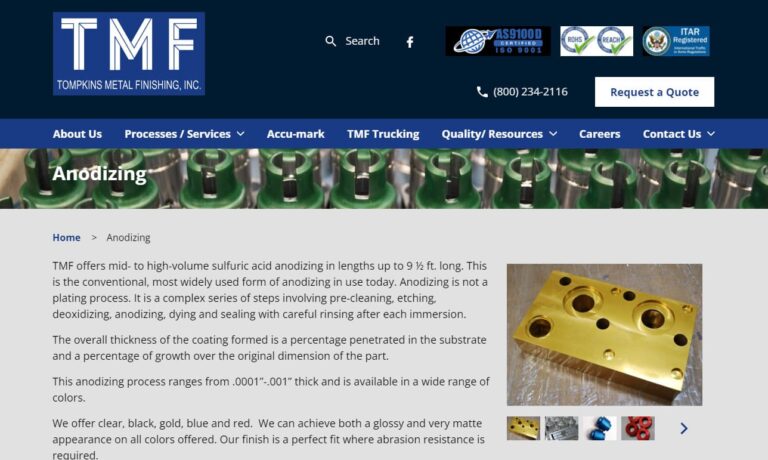
ISO 9001 CERTIFIED. CMT offers clear and colored anodize, black anodizefor die castings, chromate conversion and a complete line of metalfinishes, including paint and powder coat. We have OEM pricing with anormal turnaround time of three days and next-day service is available.

At K & L Anodizing Corporation, we specialize in delivering high-quality aluminum anodizing solutions tailored to meet the precise needs of our clients across diverse industries. With a focus on enhancing the durability, appearance, and corrosion resistance of aluminum components, we bring together advanced technology and meticulous processes to achieve optimal anodized finishes.

Dajcor Aluminum is the leading Canadian supplier of extruded, fabricated/machined and anodized components and assemblies to the automotive, renewable energy, transportation, building trades, military, recreation, and consumer-product industries.

More Black Anodizing Manufacturers
There are many types of anodizing acids, including sulfuric and chromic as the major anodizing contenders. However, some acids such as organic and boric are used in custom anodizing situations because they can offer more control in smaller settings. Metals commonly anodized are aluminum, titanium, magnesium and zinc. The new characteristics of an anodized metal are increased strength and corrosion resistance, a thicker and smoother protector then regular paint or metal plating. However, the process does make the metal more brittle, so extreme temperatures can cause damage. Depending on the style of anodizing and the type of metal, dying the product is possible.
Because the basic black dye is made from an inorganic substance, a chemical mixture called ferric ammonium oxalate, dyes used in black anodizing tend to be more lightfast. The same chemical is used to produce gold dye. To be lightfast means that the colors tend not to fade as quickly. This is true of any inorganic dye used during an anodizing process.
Black anodizing is produced in the same basic fashion that all colors for anodizing are produced, although there are a couple alternative processes too. Most anodizing processes, such as the sulfuric acid, make the surface of a metal more porous and therefore able to soak and retain the color of dyes. So directly after the major chemical shift in the metal's crystal structure, a dye can be applied.
Once a metal has been dyed, hot water or steam, often mixed with nickel acetate, is used to seal the surface and to convert the oxide into its hydrated form. This process decreases the potential of bleeding and can improve corrosion resistance. A black anodized product can also be made by way of metal dyes, which are electrolytically deposited in the pores.
Organic dyes are actually used during the chemical immersion of a product. The dying process is utilized in almost every industry and application non-colored anodized products are. A couple examples include the electronic field, which sells colored Mp3 players, flashlights and cameras, and the cooking industry, which often markets two-toned cookware.

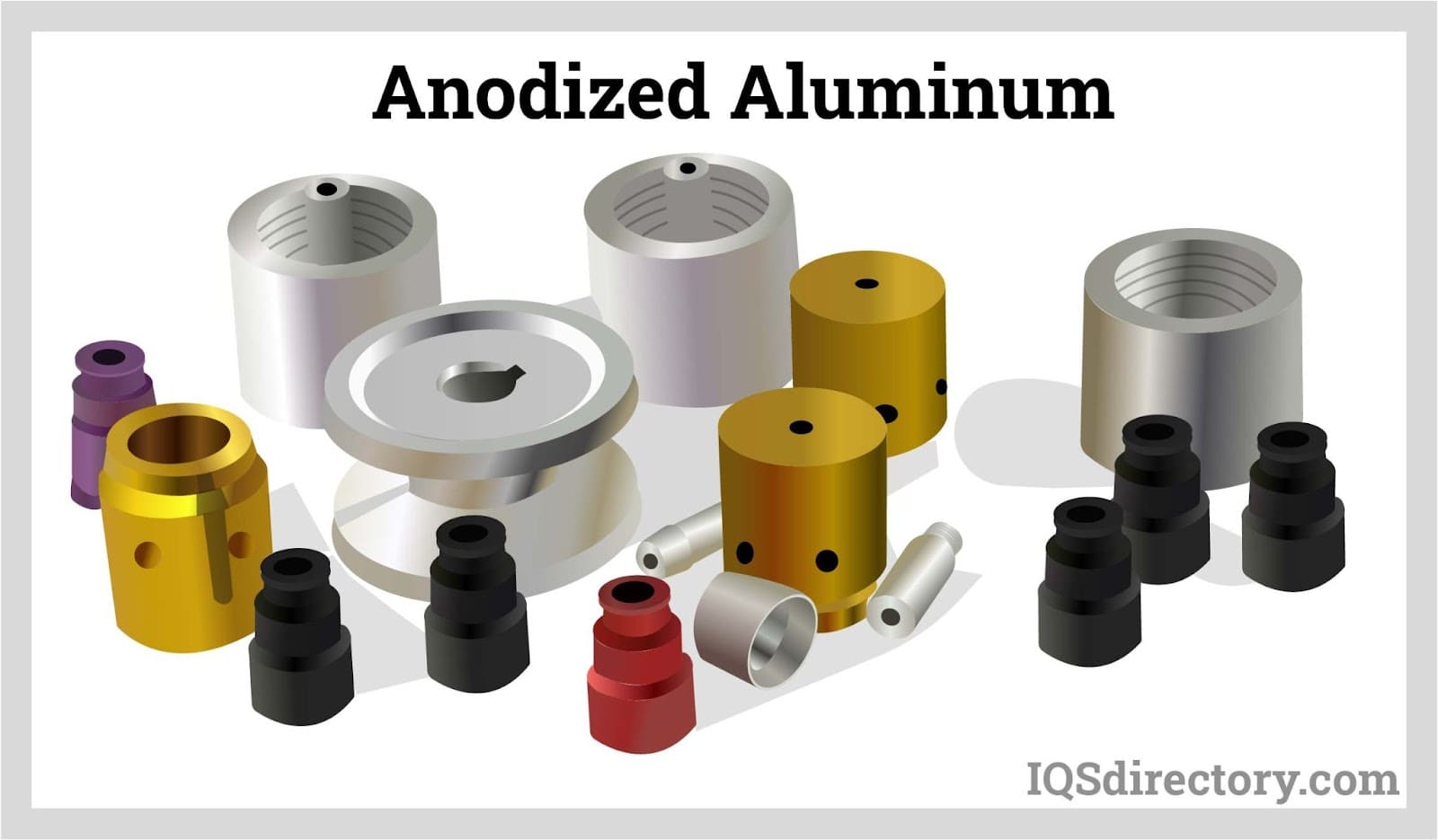








 Aluminum Anodizing
Aluminum Anodizing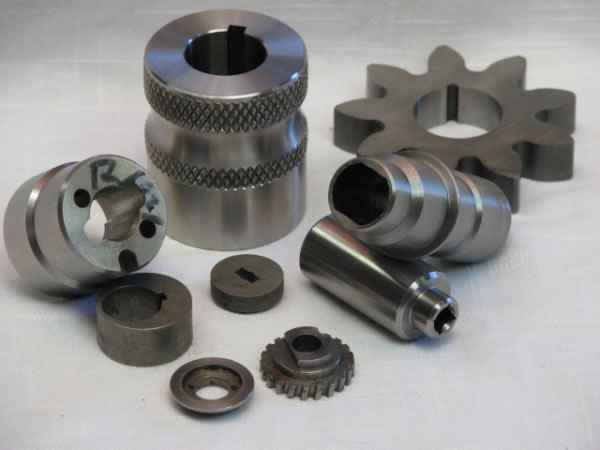 EDM
EDM Electroless Nickel Plating
Electroless Nickel Plating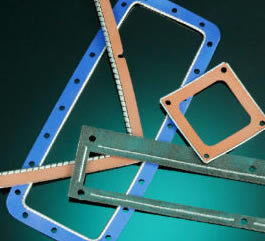 EMI Shielding
EMI Shielding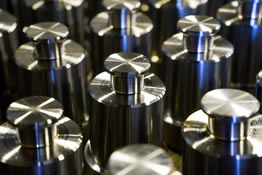 Heat Treating
Heat Treating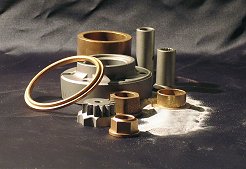 Metal Coating Services
Metal Coating Services Castings & Forgings
Castings & Forgings Bulk Material Handling
Bulk Material Handling Electrical & Electronic Components
Electrical & Electronic Components Flow Instrumentation
Flow Instrumentation Hardware
Hardware Material Handling Equipment
Material Handling Equipment Metal Cutting Services
Metal Cutting Services Metal Forming Services
Metal Forming Services Metal Suppliers
Metal Suppliers Motion Control Products
Motion Control Products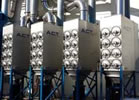 Plant & Facility Equipment
Plant & Facility Equipment Plant & Facility Supplies
Plant & Facility Supplies Plastic Molding Processes
Plastic Molding Processes Pumps & Valves
Pumps & Valves Recycling Equipment
Recycling Equipment Rubber Products & Services
Rubber Products & Services